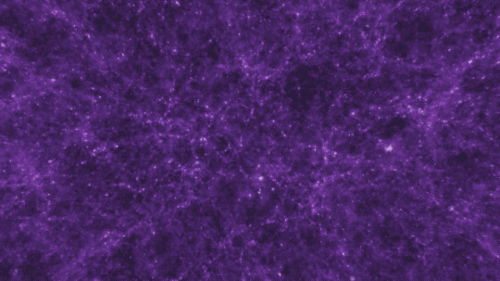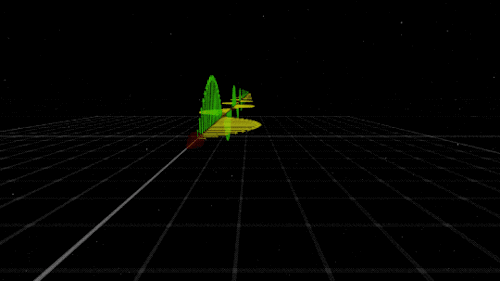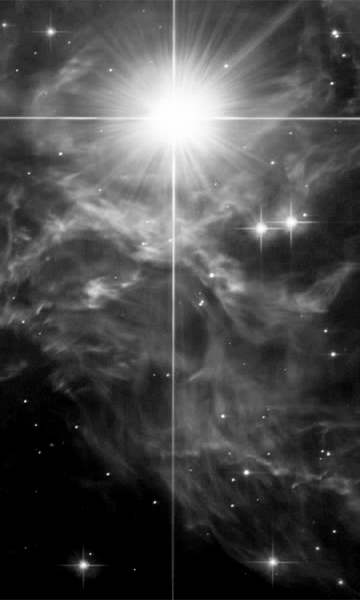May The Four Forces Be With You!
May the Four Forces Be With You!
May the force be with you? Much to learn you still have, padawan. In our universe it would be more appropriate to say, “May the four forces be with you.”

There are four fundamental forces that bind our universe and its building blocks together. Two of them are easy to spot — gravity keeps your feet on the ground while electromagnetism keeps your devices running. The other two are a little harder to see directly in everyday life, but without them, our universe would look a lot different!
Let’s explore these forces in a little more detail.
Gravity: Bringing the universe together

If you jump up, gravity brings you back down to Earth. It also keeps the solar system together … and our galaxy, and our local group of galaxies and our supercluster of galaxies.
Gravity pulls everything together. Everything, from the bright centers of the universe to the planets farthest from them. In fact, you (yes, you!) even exert a gravitational force on a galaxy far, far away. A tiny gravitational force, but a force nonetheless.

Credit: NASA and the Advanced Visualization Laboratory at the National Center for Supercomputing and B. O'Shea, M. Norman
Despite its well-known reputation, gravity is actually the weakest of the four forces. Its strength increases with the mass of the two objects involved. And its range is infinite, but the strength drops off as the square of the distance. If you and a friend measured your gravitational tug on each other and then doubled the distance between you, your new gravitational attraction would just be a quarter of what it was. So, you have to be really close together, or really big, or both, to exert a lot of gravity.
Even so, because its range is infinite, gravity is responsible for the formation of the largest structures in our universe! Planetary systems, galaxies and clusters of galaxies all formed because gravity brought them together.
Gravity truly surrounds us and binds us together.
Electromagnetism: Lighting the way

You know that shock you get on a dry day after shuffling across the carpet? The electricity that powers your television? The light that illuminates your room on a dark night? Those are all the work of electromagnetism. As the name implies, electromagnetism is the force that includes both electricity and magnetism.
Electromagnetism keeps electrons orbiting the nucleus at the center of atoms and allows chemical compounds to form (you know, the stuff that makes up us and everything around us). Electromagnetic waves are also known as light. Once started, an electromagnetic wave will travel at the speed of light until it interacts with something (like your eye) — so it will be there to light up the dark places.

Like gravity, electromagnetism works at infinite distances. And, also like gravity, the electromagnetic force between two objects falls as the square of their distance. However, unlike gravity, electromagnetism doesn’t just attract. Whether it attracts or repels depends on the electric charge of the objects involved. Two negative charges or two positive charges repel each other; one of each, and they attract each other. Plus. Minus. A balance.
This is what happens with common household magnets. If you hold them with the same “poles” together, they resist each other. On the other hand, if you hold a magnet with opposite poles together — snap! — they’ll attract each other.
Electromagnetism might just explain the relationship between a certain scruffy-looking nerf-herder and a princess.
Strong Force: Building the building blocks

Credit: Lawrence Livermore National Laboratory
The strong force is where things get really small. So small, that you can’t see it at work directly. But don’t let your eyes deceive you. Despite acting only on short distances, the strong force holds together the building blocks of the atoms, which are, in turn, the building blocks of everything we see around us.
Like gravity, the strong force always attracts, but that’s really where their similarities end. As the name implies, the force is strong with the strong force. It is the strongest of the four forces. It brings together protons and neutrons to form the nucleus of atoms — it has to be stronger than electromagnetism to do it, since all those protons are positively charged. But not only that, the strong force holds together the quarks — even tinier particles — to form those very protons and neutrons.
However, the strong force only works on very, very, very small distances. How small? About the scale of a medium-sized atom’s nucleus. For those of you who like the numbers, that’s about 10-15 meters, or 0.000000000000001 meters. That’s about a hundred billion times smaller than the width of a human hair! Whew.
Its tiny scale is why you don’t directly see the strong force in your day-to-day life. Judge a force by its physical size, do you?
Weak Force: Keeping us in sunshine

If you thought it was hard to see the strong force, the weak force works on even smaller scales — 1,000 times smaller. But it, too, is extremely important for life as we know it. In fact, the weak force plays a key role in keeping our Sun shining.
But what does the weak force do? Well … that requires getting a little into the weeds of particle physics. Here goes nothing! We mentioned quarks earlier — these are tiny particles that, among other things, make up protons and neutrons. There are six types of quarks, but the two that make up protons and neutrons are called up and down quarks. The weak force changes one quark type into another. This causes neutrons to decay into protons (or the other way around) while releasing electrons and ghostly particles called neutrinos.
So for example, the weak force can turn a down quark in a neutron into an up quark, which will turn that neutron into a proton. If that neutron is in an atom’s nucleus, the electric charge of the nucleus changes. That tiny change turns the atom into a different element! Such reactions are happening all the time in our Sun, giving it the energy to shine.
The weak force might just help to keep you in the (sun)light.

All four of these forces run strong in the universe. They flow between all things and keep our universe in balance. Without them, we’d be doomed. But these forces will be with you. Always.
You can learn more about gravity from NASA’s Space Place and follow NASAUniverse on Twitter or Facebook to learn about some of the cool cosmic objects we study with light.
Make sure to follow us on Tumblr for your regular dose of space: http://nasa.tumblr.com
More Posts from Dangerous-space and Others

This is the Tarantula Nebula! 🕷🕸🕷🕸🕷🕸
This star forming region is so big that it is 160,000 light years across! At it’s center, there are a bunch of stars totalling 450,000 solar masses that produce the Tarantula Nebula’s high luminosity and will likely become a vibrant globular cluster. ✨✨✨
Taken by me (Michelle Park) using the Slooh Chile One telescope on November 16th, 2020 at 5:27 UTC.
May Ms. Johnson forever rest in peace knowing she helped forward humanity to the stars.
Mathematician. Leader. Heroine. Remembering Hidden Figure Katherine Johnson
Tonight, count the stars and remember a trailblazer.

We’re saddened by the passing of celebrated #HiddenFigures mathematician Katherine Johnson. She passed away at 101 years old.

An America hero, Johnson’s legacy of excellence broke down racial and social barriers while helping get our space agency off the ground.

Once a “human computer”, she famously calculated the flight trajectory for Alan Shepard, the first American in space.

And when we began to use electronic computers for calculations, astronaut John Glenn said that he’d trust the computers only after Johnson personally checked the math.

As a girl, Katherine Johnson counted everything. As a mathematician, her calculations proved critical to our early successes in space travel.

With slide rules and pencils, Katherine Johnson’s brilliant mind helped launch our nation into space. No longer a Hidden Figure, her bravery and commitment to excellence leaves an eternal legacy for us all.
“We will always have STEM with us. Some things will drop out of the public eye and will go away, but there will always be science, engineering and technology. And there will always, always be mathematics.” - Katherine Johnson 1918 -2020
May she rest in peace, and may her powerful legacy inspire generations to come! What does Katherine Johnson’s legacy mean to you? Share in the comments.
Make sure to follow us on Tumblr for your regular dose of space: http://nasa.tumblr.com

Timelapse of Cepheid variable star RS Puppis taken by the Hubble Space Telescope. Light echoes ripple through the surrounding nebula as the star pulses in a 41 day cycle.
Hello!! Its wonderful to be able to ask questions, thank you!
About Perseverance, does it have a self-repair option? And as Curiosity is still operational, will they run missions together? Or will they split up to cover more distance?
Is this a sign that we're close to being able to set foot on Mars?
My final question is how do you receive the messages from such a long distance?
Thanks for all your hard work! 加油/Good luck!
“Is this a sign that we are close to being able to set foot on Mars?”

my instagram
I wonder how likely it would be for NASA to find another planet like ours that has CO2 emissions detected from Hubble. That would be evidence of civilization and people on another planet we could possibly make contact with. I wouldn’t be surprised if we sent over a little Hello package (sterile, of course, to prevent a fatal epidemic on their world or maybe we could send some chemicals that they could know).
When we get to that point, I know we’ll have that figured out. I just hope it’s within my lifetime. Humanity refuses to notice just how close we are to interplanetary travel and comminication. There are tens of millions of planets out there suitable for intelligent life. Will we ever get to meet them?


M83, Southern Pinwheel




NASA and SpaceX launch astronauts Robert Behnken and Douglas Hurley to the International Space Station. [May 30th, 2020]

Milky Way at Dowerin, Western Australia
Nikon d5500 - 35mm - ISO 4000 - f/2.5 - Foreground: 5 x 20 seconds - Sky: 11 x 30 seconds - iOptron SkyTracker
-
 glaciesdeam liked this · 2 months ago
glaciesdeam liked this · 2 months ago -
 wolfsrahne28 liked this · 1 year ago
wolfsrahne28 liked this · 1 year ago -
 brandon1997 liked this · 1 year ago
brandon1997 liked this · 1 year ago -
 demichrising liked this · 1 year ago
demichrising liked this · 1 year ago -
 novelteastuff liked this · 1 year ago
novelteastuff liked this · 1 year ago -
 vermilionvexation liked this · 1 year ago
vermilionvexation liked this · 1 year ago -
 uriigamii liked this · 1 year ago
uriigamii liked this · 1 year ago -
 uhleesuhsimports reblogged this · 1 year ago
uhleesuhsimports reblogged this · 1 year ago -
 ivansirko liked this · 2 years ago
ivansirko liked this · 2 years ago -
 fabcity liked this · 2 years ago
fabcity liked this · 2 years ago -
 raf-science reblogged this · 2 years ago
raf-science reblogged this · 2 years ago -
 abelhaplanta reblogged this · 2 years ago
abelhaplanta reblogged this · 2 years ago -
 wherethestoriesare reblogged this · 2 years ago
wherethestoriesare reblogged this · 2 years ago -
 wherethestoriesare liked this · 2 years ago
wherethestoriesare liked this · 2 years ago -
 doa333 reblogged this · 2 years ago
doa333 reblogged this · 2 years ago -
 doa333 liked this · 2 years ago
doa333 liked this · 2 years ago -
 tephrahedron liked this · 3 years ago
tephrahedron liked this · 3 years ago -
 christine-loveseex733828-blog liked this · 3 years ago
christine-loveseex733828-blog liked this · 3 years ago

22 year old space blogger•Not just a space blogger.Also a worrier. •
75 posts